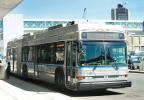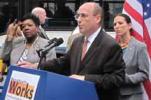May 7, 2009
 A bus on the Silver LineState and city leaders this week announced a $100 million federal stimulus project to greatly improve public transportation along Blue Hill Avenue from Mattapan to Dudley Square, including a new connection to South Station.
A bus on the Silver LineState and city leaders this week announced a $100 million federal stimulus project to greatly improve public transportation along Blue Hill Avenue from Mattapan to Dudley Square, including a new connection to South Station.
It isn’t the light rail service that Roxbury’s transportation advocates have clamored for since the Orange Line was pulled off Washington Street in the late ’80s. And many in Mattapan were taken aback after being left out of the loop on the new proposal. Yet, it is a direct connection to downtown from a host of underserved neighborhoods in Mattapan and Dorchester and transportation advocates seem to be warming up to the plan.
“With smart, strategic use of federal recovery funds we can bring rapid transit to some of Boston’s busiest bus routes, connecting key neighborhoods and delivering reliable service for tens of thousands of commuters who rely on the MBTA,†said Gov. Deval Patrick at a press conference in Dudley Square Monday.
Though some of the Route 28 service will likely resemble a typical city bus, the state’s goal, according to Executive Office of Transportation spokesman Colin Durrant, is to shoot for “true Bus Rapid Transit.â€
“That’s the goal, to bring real bus rapid transit… as much as we can,†said Durrant this week. “The 28 is pretty frequent. But what we heard from riders is that buses bunch up or the bus gets stuck in traffic, that sort of thing. So this will make the service more reliable.â€
In the winter of 2007, the 28 was averaging 12,071 weekday boardings according to the MBTA, making it the fifth busiest line in the city.
The design stage, which will include public input, has just begun, said Durrant. But, he emphasized, the 28’s enhancement would include far more features of BRT than are included in the often-criticized Silver Line.
Transportation advocates cite a number of elements that put the ‘Rapid’ in Bus Rapid Transit. Chief among them are dedicated bus lanes (ideally physically separate from traffic), traffic signal priority (buses get an early green), and high-frequency all-day service. Also important for speedy service are off-bus fare collection, low-floor articulated buses and enclosed stations.
All of this, if implemented, would make a system fairly unfamiliar to the American eye, but far faster and more efficient than most American bus routes.
 The proposed corridor of the enhanced Route 28, along with existing subway and commuter rail lines. Courtesy EOT
The proposed corridor of the enhanced Route 28, along with existing subway and commuter rail lines. Courtesy EOT
Already proposed in the state’s plan are dedicated bus lanes that would travel down the middle of Blue Hill Avenue, much like trolleys travel down the center of Commonwealth Avenue in Allston-Brighton. Along the narrower Warren Avenue and Essex Street downtown, the buses would have only one dedicated lane but use “queue jumping†at intersections—which combines a space for the bus to pull off to the right of traffic and take advantage of a pre-green light so it can beat regular traffic to the other side.
The Boston Transportation Department pushed back on signal prioritization during the building of the Silver Line, citing the congestion that could be caused on the streets crossing Washington. Though it is in place on the silver line, the buses only get priority when the system’s electronic monitors flag them as late.
 Transportation Secretary James Aloisi spoke at a press conference held on Monday in Dudley Square to announce the Silver Line expansion and enhanced bus service into Mattapan. Rep. Gloria Fox, left, and State Senator Sonia Chang-Diaz look on. Photo c
Transportation Secretary James Aloisi spoke at a press conference held on Monday in Dudley Square to announce the Silver Line expansion and enhanced bus service into Mattapan. Rep. Gloria Fox, left, and State Senator Sonia Chang-Diaz look on. Photo c
The TransMilenio BRT project in Bogota, Columbia, which is considered a model of “true BRT,†includes large enclosed-glass stations where passengers pay their fares, later boarding through a set of glass doors on the station that open in synchronization with the bus’s doors. This saves time by eliminating the need to have each passenger pay as they board.
Durrant said he wasn’t sure how the stations along the new 28 would look, but reiterated that the state wants to do everything possible to make a true BRT line.
Many of the transportation advocates that have traditionally called for light rail are now tentatively giving early support for the line—but only if it is built as true BRT—and not simply a fancy-looking bus with shiny new bus shelters. They also demand the involvement of the community in the planning process, which the state has already agreed to.
“They need to do it right,†said Lee Matsueda of the T Riders Union. “The stations should be heated with fare collection machines inside. And they need later service.â€
“If it’s true bus rapid transit, everybody would agree that it’s an improvement on Blue Hill Avenue,†said Eric Bourassa of MassPIRG, who has been working alongside TRU and the On The Move Coalition on transportation issues. Many of the activists are leery of approving anything but light rail because of the precedent it would set, he said, “but the challenge with light rail is just the cost of it.â€
Other observers are already beginning to pick out improvements they’d like to aim for. State Rep. Byron Rushing said he would like to combine the two new projects to make one bus line that stretches all the way from Mattapan Square to South Station. “They want that to be two routes. But to switch at Dudley doesn’t make any sense.â€
To kick start wider community input, Mattapan’s array of legislators is already throwing together a meeting at the new Mattapan Branch of the Boston Public Library for the last week of May, exact date to be announced.

State Reps. Linda Dorcena Forry, Willie Mae Allen, Sens. Jack Hart and Sonia Chang-Diaz and others—many of whom were taken aback because they were not told about the project until the media and the public was on Monday—are organizing what they call a ‘Transportation Summit.’
“We just want to make sure that it’s coordinated properly,†said Forry. “We think $100 million is great that it’s coming into Mattapan. But we want to make sure residents have their say.â€
According to the EOT, the new connection to South Station would not be complete until at least September, and the 28 enhancement not before January 2012. As many in the neighborhood know, however, MBTA construction projects are rarely finished on time.
Villages:
Topics:
Tags:


